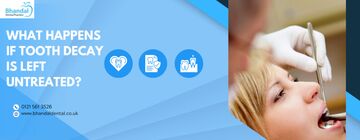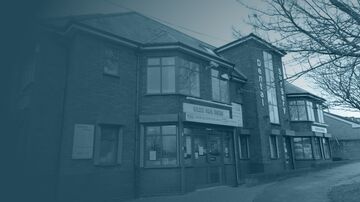
December 7, 2023
A full guide to the prevention and treatment of dental decay
Learn everything you need to know about the prevention and treatment of tooth decay so you can keep your mouth healthy.
Tooth decay is a common but highly treatable and preventable condition. With better oral hygiene, tooth decay can often be avoided, but some people are more prone to tooth decay than others.
Tooth decay is most commonly seen on the chewing edge of the teeth. This is because it is where food can accumulate and allow bacteria to thrive. It can also be seen in other areas as a result of trauma to the tooth such as a crack or chip.
If you’re curious about what you can do to treat and prevent tooth decay, read on. We’re sharing our thoughts on tooth decay and how you can take simple steps to safeguard your oral health.

What causes dental decay?
Dental decay is caused by bacteria that leads to infection in the tooth. When we eat, the sugar and starch in our food mixes with saliva which produces an acid that attacks the tooth surface. If this is not rinsed away, it can sit on the tooth surface and attach the delicate enamel.
This layer of bacteria is known as plaque, a sticky substance found on the teeth. When it hardens, it is known as tartar and can cause discolouration. Plaque attacks the enamel covering the surface of your teeth. Once the enamel is eroded, the dentin layer is exposed. This is softer and more susceptible to decay.
Once bacteria is inside the tooth it will continue to erode the delicate tooth material, eventually finding its way to the tooth root where it can cause an incredibly painful infection. This may also lead to an abscess.

What can be done for tooth decay?
Prevention is best when it comes to tooth decay, but there are treatments to help reverse the damage and restore the damaged tooth. The most common treatment is a filling. During this treatment, the dentist uses a drill to remove the damaged and infected portion of the tooth. This is then filled with either dental amalgam or white composite resin.
If the damage is more extensive and has found its way to the tooth root, a root canal will be required. This is a delicate procedure in which your dentist will use a drill and small tools to clean out the roots of an infected tooth. They then fill the roots to strengthen them and top it with a crown.
In some cases, the tooth may be too damaged to be able to save it. In this situation, an extraction and replacement might be required. To remove a damaged tooth, your dentist will gently rock it back and forth to loosen the tooth roots until it can be removed.

What happens if tooth decay is left untreated?
Left untreated, the infection will eventually make its way to the root of the tooth. This will be very painful and lead to excruciating toothache that will be difficult to ignore.
The issue with this type of infection is that it comes in waves. It might hurt a lot for a while and then the pain will go away. This leads people to assume the issue is fixed, but this is far from the case. What is happening is that more of the tooth root is dying which kills the nerve endings. The infection is still there, you just can’t feel it for a while.
The infection will eventually return and could develop into a painful abscess. This can lead to dangerous swelling in the cheek, jaw, tongue and throat. It’s vital to seek help at the first sign of an issue to enable your dentist to protect and preserve your natural tooth.
If the tooth is too damaged by decay, the only option will be to remove it, which will leave you with a gap in your smile.

How do you prevent tooth decay?
Tooth decay might sound scary, but there are simple steps you can take to help prevent it. Simple things like brushing your teeth twice and day and flossing regularly will go a long way in helping to prevent tooth decay.
You should also be mindful of how your food and lifestyle choices might impact your oral health. For example, smoking will put you at greater risk of tooth decay because this habit dries out your mouth, which means you have less saliva to rinse away food debris and bacteria.
Diet will also have a big impact on your oral health and the risk of tooth decay. A diet that is high in sugary sweets, starchy foods and refined carbs will make it more likely that you will have some form of tooth decay. Very chewy sweets and fizzy drinks are some of the worst culprits for tooth decay as they will erode the enamel of your teeth and also stick to the surface.
Regular trips to the dentist are also recommended as there may be early signs of tooth decay that aren’t obvious to you. Rather than waiting for a painful condition to develop, you can visit the dentist at least once a year to help stop tooth decay in its tracks. A dentist will be able to spot the early signs of tooth decay before it becomes a much bigger problem.

Closing thoughts
Tooth decay is all too common but also very treatable. When it is caught early, it can often be remedied with a simple filling. Once the infection becomes more advanced, a root canal and crown restoration might be required. If the infection causes extensive damage, an extraction might be recommended.
Simple steps can help you to avoid the need for any treatment. Regular checkups with your dentist and brushing your teeth twice a day is often sufficient to help reduce the risk of tooth decay.
You can also consider your lifestyle choices and make small changes to protect your teeth. This could include avoiding snacking between meals and making sure that sweets are only an occasional treat. If you’re worried about the effects of tooth decay, book a routine checkup today.
Join the practice
We offer excellent care and advice regarding our wide range of treatments to all of our patients.
Contact our main practice
0121 561 3526Find your nearest practice
Related articles
You may also be interested in
